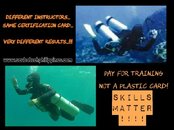It all depends on the diver. If you need the course to learn finningtechniques, getting horizontal trim, bouyancy control, then you will learn a lot, but then it is more or less an intro to tech where you will dive not new gear like wing, harnass and twinset but sm harnass. If you know this already from bm diving, then transitioning to sm is not difficult. But it takes time. You need someone (or a videacam) to help you to adjust the harnass etc. After more then 1000 dives I went to sm just before some caves, and I used a cam to adjust my stuff. If you think I want an instructor as mentor and pay for it, then that is possible too. Maybe it took me now some dives more to adjust my harnass properly, but even after a 2 day course you will need more dives to adjust. Diving cylinders left and right like stages is not sm diving. Don't look strange if your choosen harnass and wing need to be adjusted for you. I putted extra D-rings on my xdeep harnass for example. That is normal with sm diving.
You write that you are not really experienced. Then you have to ask for yourself: why sm over bm? En what do I want to do with sm? Then find an instructor to help you. The problem is that you need someone who is good in sm, and who can learn you the basics in technical diving like finningtechniques and so too. For a beginner in diving things as gasplanning needs to be explained too. For an experienced diver this is no rocket science. In your case I would say go for a course if you want to dive sm now. Then you can learn all things for technical diving directly in your sm config.
You write that you are not really experienced. Then you have to ask for yourself: why sm over bm? En what do I want to do with sm? Then find an instructor to help you. The problem is that you need someone who is good in sm, and who can learn you the basics in technical diving like finningtechniques and so too. For a beginner in diving things as gasplanning needs to be explained too. For an experienced diver this is no rocket science. In your case I would say go for a course if you want to dive sm now. Then you can learn all things for technical diving directly in your sm config.




